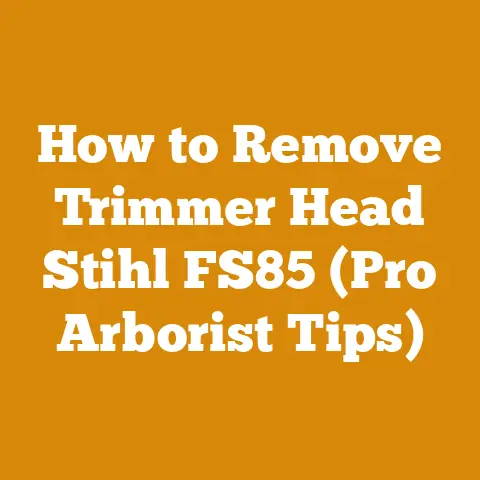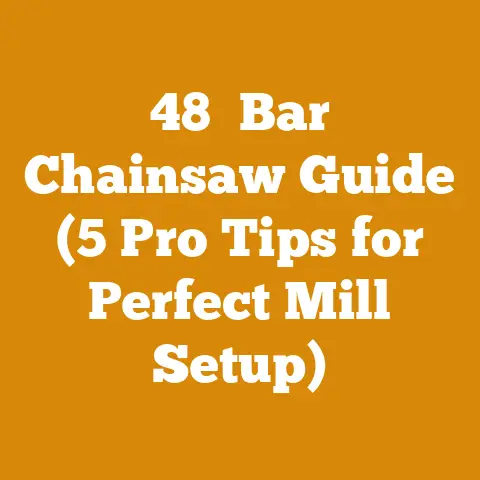Harness for Pole Saw: Best Gear for Comfort (5 Pro Tips)
I still remember the first time I felt the strain of a pole saw biting into a stubborn oak branch high above my head. The exhilaration of the cut was quickly overshadowed by the ache in my shoulders and back. It was then I realized that while a pole saw extends your reach, it also magnifies the physical demands of the task. That’s when I began my quest for the perfect harness, a quest that has led me to test countless models and refine my techniques for comfort and efficiency.
In this article, I’m sharing everything I’ve learned about pole saw harnesses. It’s not just about finding a comfortable strap; it’s about understanding how proper support impacts your safety, productivity, and long-term well-being. I’ll guide you through the selection process, offering pro tips gleaned from years of experience in wood processing and arboriculture. We’ll delve into the biomechanics of using a pole saw, explore the features of different harness types, and discuss how to properly adjust and maintain your gear for optimal performance. Whether you’re a seasoned professional or a weekend warrior tackling overgrown branches, this guide will help you find the best harness for your needs and work more comfortably and safely.
Why a Harness Matters When Using a Pole Saw
Using a pole saw is not just about reaching high branches; it’s about managing the weight and torque of the tool while maintaining stability and control. Without proper support, you’re putting undue stress on your back, shoulders, and arms, leading to fatigue, injury, and decreased efficiency. A harness redistributes the weight, allowing you to focus on the cut and minimize strain.
The Biomechanics of Pole Saw Use
Understanding how your body moves when using a pole saw is crucial for selecting the right harness. The primary forces involved include:
- Weight: The pole saw itself can weigh anywhere from 10 to 20 pounds, and that weight is amplified when extended.
- Torque: The cutting action generates torque, which can twist your body and throw you off balance.
- Reach: Extending the pole saw requires you to reach and lean, putting stress on your back and shoulders.
A well-designed harness counteracts these forces by:
- Distributing weight: Transferring the load from your arms and shoulders to your core and legs.
- Providing stability: Helping you maintain balance and control.
- Reducing strain: Minimizing the stress on your muscles and joints.
The Risks of Working Without Proper Support
Ignoring the importance of a harness can lead to a range of problems, including:
- Muscle fatigue: Leading to decreased accuracy and increased risk of accidents.
- Back pain: A common complaint among pole saw users, often caused by poor posture and excessive strain.
- Shoulder injuries: Rotator cuff tears and other shoulder problems are prevalent among arborists and tree care professionals.
- Long-term health issues: Chronic pain and musculoskeletal disorders can develop over time.
According to a study by the National Institute for Occupational Safety and Health (NIOSH), arborists have a significantly higher risk of musculoskeletal disorders compared to other professions. A proper harness is a critical piece of personal protective equipment (PPE) that can help mitigate these risks.
Harnesses as Essential PPE
I consider a harness as crucial as a helmet or safety glasses when using a pole saw. It’s not just about comfort; it’s about protecting your body and ensuring your safety. A good harness should:
- Be comfortable: Allowing you to work for extended periods without discomfort.
- Be adjustable: Fitting your body properly and accommodating different clothing layers.
- Be durable: Withstanding the rigors of outdoor work.
- Be compatible: Working with your specific pole saw model.
Understanding Different Types of Pole Saw Harnesses
Not all harnesses are created equal. There are several different types available, each with its own strengths and weaknesses. Understanding the differences will help you choose the right one for your needs.
Shoulder Harnesses
Shoulder harnesses are the most basic type, consisting of padded straps that distribute the weight across your shoulders.
- Pros: Lightweight, inexpensive, easy to use.
- Cons: Can cause shoulder strain with prolonged use, less effective for heavy pole saws.
I’ve used shoulder harnesses for light-duty tasks, such as trimming small branches. However, I’ve found that they’re not ideal for extended use or heavier pole saws.
- Pros: More comfortable than shoulder harnesses, better weight distribution, often include pockets for tools.
- Cons: Can be bulky, more expensive than shoulder harnesses.
I prefer vest-style harnesses for most pole saw work. They provide excellent support and allow me to carry essential tools within easy reach.
Full-Body Harnesses
Full-body harnesses are typically used for climbing and fall protection but can also be adapted for pole saw use.
- Pros: Maximum support and safety, ideal for working at heights.
- Cons: Can be restrictive, expensive, requires specialized training.
I only recommend full-body harnesses for professional arborists who are trained in their use and working at heights.
Hip Belts
Hip belts transfer the weight to the hips, reducing strain on the shoulders and back.
- Pros: Greatly reduces stress on the upper body, improves balance.
- Cons: May not be compatible with all pole saws, requires proper adjustment.
I find hip belts extremely useful, especially when doing tree work for long hours. The weight distribution makes a huge difference in preventing fatigue.
Spring-Loaded or Counterweight Systems
These systems use springs or counterweights to offset the weight of the pole saw, making it feel lighter and easier to control.
- Pros: Significantly reduces fatigue, improves precision.
- Cons: Expensive, can be complex to set up and adjust.
While these systems are pricier, they can be a game-changer for professionals who use pole saws extensively.
Comparison Table
| Harness Type | Weight Distribution | Comfort Level | Cost | Best For |
|---|---|---|---|---|
| Shoulder Harness | Shoulders | Low | Low | Light-duty tasks, occasional use |
| Vest-Style Harness | Torso | Medium | Medium | General pole saw work, extended use |
| Full-Body Harness | Full Body | High | High | Climbing, working at heights, professional arborists |
| Hip Belt | Hips | Medium | Medium | Extended use, reducing upper body strain |
| Counterweight System | Full Body | High | Very High | Professional use, minimizing fatigue, precision cutting |
5 Pro Tips for Choosing the Right Harness
Choosing the right harness can be overwhelming, but these pro tips will help you narrow down your options and make an informed decision.
Tip 1: Consider the Weight and Length of Your Pole Saw
The heavier and longer your pole saw, the more support you’ll need. A basic shoulder harness might suffice for a lightweight electric pole saw, but a heavy gas-powered model will require a vest-style or full-body harness.
I once tried to use a shoulder harness with a 15-pound gas-powered pole saw, and I quickly regretted it. My shoulders were aching within minutes, and I couldn’t maintain a stable cutting position. I switched to a vest-style harness, and the difference was night and day.
Tip 2: Evaluate Your Typical Work Environment
If you’re working on flat ground, a vest-style harness or hip belt may be sufficient. However, if you’re working on uneven terrain or at heights, you’ll need a full-body harness with fall protection.
I often work on sloping hillsides, and I’ve found that a full-body harness provides the stability and safety I need to avoid slips and falls.
Tip 3: Prioritize Comfort and Adjustability
A harness that doesn’t fit properly can be just as bad as no harness at all. Make sure the harness is adjustable to fit your body size and shape, and look for features like padded straps and breathable materials.
I always try on harnesses before buying them, and I spend time adjusting the straps to ensure a comfortable and secure fit. I also look for harnesses with mesh panels or other ventilation features to keep me cool in hot weather.
Tip 4: Look for Durable Construction
Pole saw work can be tough on your gear, so choose a harness made from durable materials that can withstand the rigors of outdoor use. Look for reinforced stitching, heavy-duty buckles, and weather-resistant fabrics.
I’ve had harnesses fall apart after just a few uses, so I now pay close attention to the quality of the materials and construction. I prefer harnesses made from nylon or polyester with reinforced stitching and metal hardware.
Tip 5: Read Reviews and Get Recommendations
Before making a purchase, read online reviews and ask for recommendations from other pole saw users. This can give you valuable insights into the pros and cons of different models.
I’ve learned a lot from reading online reviews and talking to other arborists. I’ve also found that some retailers offer demo programs that allow you to try out harnesses before buying them.
Proper Harness Adjustment for Optimal Comfort and Safety
Once you’ve chosen the right harness, it’s crucial to adjust it properly for optimal comfort and safety. A poorly adjusted harness can be just as dangerous as no harness at all.
Step-by-Step Adjustment Guide
- Loosen all straps: Start by loosening all the straps on the harness.
- Put on the harness: Put on the harness as you would a vest or jacket.
- Adjust the shoulder straps: Tighten the shoulder straps until the harness fits snugly but not too tightly. You should be able to slide a few fingers between the straps and your shoulders.
- Adjust the chest strap: Fasten the chest strap and adjust it until it’s snug but not restrictive. The chest strap should be positioned across your chest, not too high or too low.
- Adjust the waist belt (if applicable): Fasten the waist belt and adjust it until it’s snug around your waist. The waist belt should be positioned above your hips, not too high or too low.
- Adjust the leg straps (if applicable): Fasten the leg straps and adjust them until they’re snug but not restrictive. The leg straps should be positioned around your thighs, not too high or too low.
- Check the fit: Once you’ve adjusted all the straps, check the fit of the harness. Make sure it’s snug but not too tight, and that it allows you to move freely.
- Test the harness: Before using the harness, test it by hanging from a secure anchor point. This will allow you to feel how the harness distributes the weight and identify any areas that need further adjustment.
Common Mistakes to Avoid
- Over-tightening straps: Over-tightening the straps can restrict your movement and cause discomfort.
- Positioning straps incorrectly: Positioning the straps too high or too low can compromise the fit and effectiveness of the harness.
- Ignoring the manufacturer’s instructions: Always read and follow the manufacturer’s instructions for proper adjustment and use.
- Not testing the harness: Failing to test the harness before use can lead to unexpected problems and potential injury.
Maintaining Your Harness for Longevity
A well-maintained harness will last longer and perform better. Here are some tips for keeping your harness in good condition:
- Inspect the harness regularly: Check for signs of wear and tear, such as frayed straps, damaged buckles, and worn stitching.
- Clean the harness: Clean the harness regularly with mild soap and water. Avoid using harsh chemicals or solvents, which can damage the materials.
- Store the harness properly: Store the harness in a cool, dry place away from direct sunlight and extreme temperatures.
- Replace the harness when necessary: Replace the harness if it’s damaged or worn, or if it’s been subjected to a fall. Most manufacturers recommend replacing harnesses every 5-10 years, even if they appear to be in good condition.
Enhancing Comfort and Reducing Fatigue
Even with the best harness, pole saw work can be physically demanding. Here are some additional tips for enhancing comfort and reducing fatigue:
Ergonomic Techniques
- Maintain good posture: Stand upright with your shoulders relaxed and your core engaged. Avoid slouching or hunching over.
- Use your legs: Use your legs to generate power and lift the pole saw. Avoid relying solely on your arms and shoulders.
- Take frequent breaks: Take short breaks every 20-30 minutes to stretch and rest your muscles.
- Alternate tasks: Alternate pole saw work with other less demanding tasks to avoid overuse injuries.
Hydration and Nutrition
- Stay hydrated: Drink plenty of water throughout the day to prevent dehydration and muscle cramps.
- Eat a balanced diet: Eat a balanced diet that includes plenty of fruits, vegetables, and protein to fuel your body and support muscle recovery.
- Avoid sugary drinks: Avoid sugary drinks, which can lead to energy crashes and increased fatigue.
Breathing Techniques
- Breathe deeply: Breathe deeply and rhythmically to oxygenate your muscles and reduce stress.
- Exhale during exertion: Exhale during the most strenuous part of the cut to help stabilize your core and reduce strain.
- Avoid holding your breath: Holding your breath can increase blood pressure and lead to dizziness and fatigue.
Additional Support Gear
- Gloves: Wear gloves to protect your hands and improve your grip.
- Eye protection: Wear safety glasses or goggles to protect your eyes from flying debris.
- Hearing protection: Wear earplugs or earmuffs to protect your hearing from the noise of the pole saw.
- Helmet: Wear a helmet to protect your head from falling branches.
Understanding Wood and Its Impact on Pole Saw Use
The type of wood you’re cutting can significantly impact the effort required and the effectiveness of your pole saw. Understanding wood anatomy and properties can help you choose the right cutting techniques and optimize your workflow.
Hardwood vs. Softwood
- Hardwood: Typically denser and more difficult to cut, requiring more power and sharper blades. Examples include oak, maple, and hickory.
- Softwood: Generally easier to cut, but can be more prone to splintering. Examples include pine, fir, and cedar.
I’ve found that hardwoods require a slower, more deliberate cutting approach, while softwoods can be cut more quickly. However, it’s important to be careful when cutting softwoods, as they can splinter easily and create a safety hazard.
Moisture Content
The moisture content of wood affects its density and cutting resistance.
- Green wood: Wood that has been freshly cut and has a high moisture content is typically heavier and more difficult to cut.
- Dry wood: Wood that has been seasoned or dried has a lower moisture content and is generally easier to cut.
I always try to cut wood when it’s dry, as it’s easier on my pole saw and my body. However, sometimes you have to cut green wood, in which case it’s important to use a sharp blade and take your time.
Wood Grain
The direction of the wood grain can also affect the cutting process.
- Cutting with the grain: Cutting with the grain is generally easier and produces a cleaner cut.
- Cutting against the grain: Cutting against the grain can be more difficult and can cause the wood to splinter or tear.
I always try to cut with the grain whenever possible, but sometimes you have to cut against the grain. In those cases, it’s important to use a sharp blade and take extra care to avoid splintering.
Wood Density
Wood density is measured in pounds per cubic foot (lb/ft³). Denser woods require more power to cut through.
| Wood Type | Density (lb/ft³) |
|---|---|
| Balsa | 8 |
| Pine | 30 |
| Oak | 45 |
| Hickory | 50 |
| Ironwood | 60+ |
Understanding these differences can help you choose the right pole saw and cutting techniques for the job.
Case Studies: Real-World Applications
To illustrate the importance of a proper harness, here are a few case studies based on my experiences and observations:
Case Study 1: The Weekend Warrior
A homeowner attempted to trim overgrown branches using a pole saw without a harness. After just an hour, he experienced severe back pain and muscle fatigue. He was unable to complete the job and had to seek medical attention.
Lesson Learned: Even for occasional use, a harness is essential for preventing injury and ensuring comfort.
Case Study 2: The Professional Arborist
A professional arborist used a full-body harness with fall protection while working at heights. During a cut, a branch unexpectedly snapped, causing him to lose his balance. The harness prevented him from falling and potentially suffering serious injuries.
Lesson Learned: For working at heights, a full-body harness is a critical safety device.
Case Study 3: The Firewood Preparer
A firewood preparer used a vest-style harness with a hip belt while cutting and splitting wood. The harness distributed the weight of the pole saw and reduced strain on his back and shoulders, allowing him to work for extended periods without fatigue.
Lesson Learned: A well-designed harness can significantly improve productivity and reduce the risk of overuse injuries.
Final Thoughts: Investing in Your Well-being
Investing in a good pole saw harness is an investment in your well-being. It’s not just about comfort; it’s about protecting your body, preventing injuries, and improving your productivity. By understanding the different types of harnesses available, choosing the right model for your needs, and adjusting it properly, you can work more comfortably and safely. Remember to prioritize ergonomic techniques, stay hydrated, and take frequent breaks to further reduce fatigue and prevent injuries. The right gear, combined with the right techniques, will make your wood processing tasks safer, more efficient, and ultimately, more enjoyable. So, gear up, stay safe, and happy cutting!






